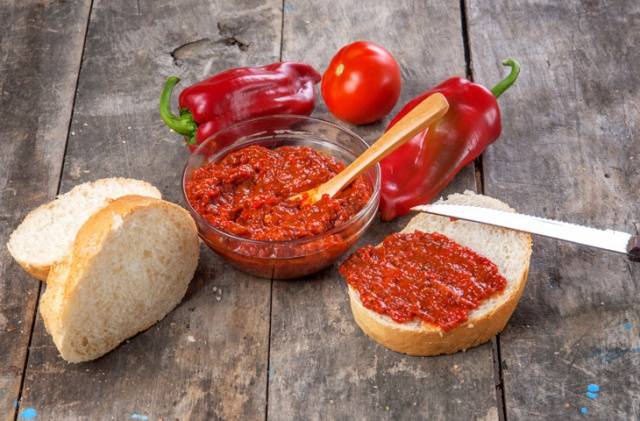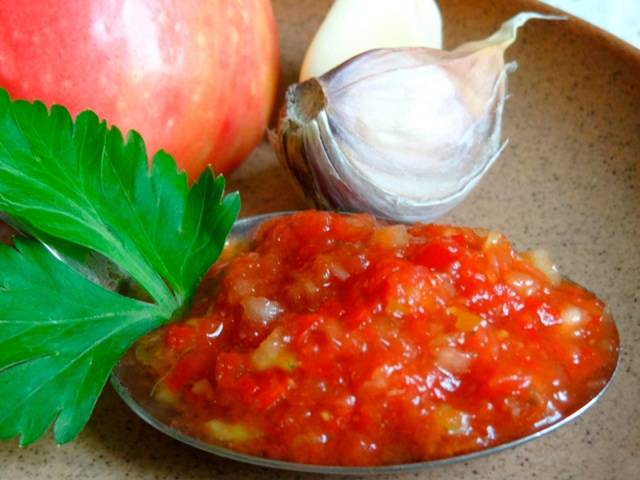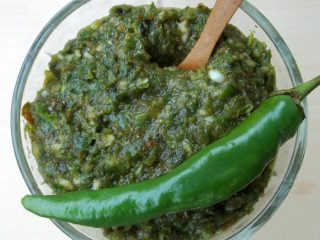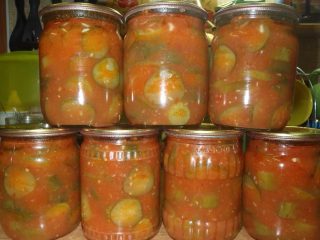Adjika is a seasoning originally from the Caucasus. It has a rich taste and aroma. Served with meat, complements its taste. The seasoning has migrated to the cuisines of other countries, is prepared by culinary specialists, and is always a huge success.
If initially adjika was prepared from pepper, garlic and various herbs, now other ingredients are added to it aimed at softening the pungent, burning taste. These can be tomatoes, sweet or sour apples, carrots, sweet bell peppers.
In the middle zone, where it is customary to make winter preparations, the seasoning is preserved for long-term storage using vinegar and heat treatment. But even in the absence of vinegar in the recipe, the preparations are well stored in a city apartment, since the high content of garlic and pepper - natural antiseptics, does not allow the development of fungi and microbes.
The appearance of adjika has also changed. Now it is not only a thick seasoning based on red pepper, but also a tomato sauce with spices, caviar or a vegetable appetizer. Which have moved from the category of seasoning to the category of independent dishes. And they are served not only with meat, but also with any main course. Good for a snack with a piece of white or black bread.
Methods for preparing adjika from carrots and apples for the winter
Adjika from carrots and apples does not have a burning taste, it turns out to be sourish-sweet, no less aromatic and thick. Spicy lovers, by changing the proportions, can get a seasoning that meets their needs.
Recipe 1 (Basic recipe)
What you will need:
- Carrots – 3 pieces;
- Tomatoes – 1.3 kg;
- Table salt - to taste;
- Hot pepper - to taste;
- Bell pepper – 0.5 kg;
- Garlic – 100 g;
- Sunflower oil – 100 g.
How to cook:
- All vegetables and apples should be pre-washed, peppers and apples should be cleared of seeds, and carrots should be cleared of the top coarse layer. Tomatoes can also be peeled. Don’t be lazy and do this procedure: cut the tomatoes and pour boiling water over them, then cold water. After such a contrasting bath, the skin of the tomatoes can be easily removed. Then all the vegetables are cut into pieces of a convenient size for feeding into a meat grinder.
- The garlic is peeled. Since you will need to peel a lot of garlic, you can use a clever method. Divide the garlic into cloves, make a cut at the bottom and place in a container with a lid. Shake vigorously for 2-3 minutes. Open the lid and select the peeled slices.
- Vegetables are chopped using a meat grinder and seasoned with sunflower oil. And cook on moderate gas for 40 minutes to 1 hour, stirring from time to time.
Do not use a lid, this will thicken the mixture better. Cook in a thick-walled container, preferably in a cauldron, then the vegetables will not burn. - At the end of cooking, the mass will begin to puff and splash. Now is the time to loosely cover the dish with the lid.
- The garlic is chopped. Use a kitchen gadget for this, such as a mill. You will need to grind the garlic to a paste.
- At the end of cooking, add garlic and salt and bring to a boil again. Focus on your taste.You may need to add salt, and you can also add granulated sugar if the taste seems sour.
- The hot mass is laid out in prepared, sterilized jars, immediately sealed, turned over and allowed to cool under a blanket.
- Adjika from carrots and apples with tomatoes is stored at room temperature, in a dark place. A refrigerator is used to store an open container.
The cooking recipe is simple, the most popular, as it is prepared from simple available products and does not require complex preparation. This adjika can be used as a ready-made sauce for main courses or added when preparing soups and stews.
Recipe 2 (With onions)
What you will need:
- Carrots – 1 kg;
- Sour apples – 1 kg;
- Bulgarian sweet pepper – 1 kg;
- Tomatoes – 2 kg;
- Onions – 1 kg;
- Hot pepper – 1-2 pods;
- Salt - to taste;
- Granulated sugar – 3 tbsp. l.;
- Garlic – 100-200 g;
- Sunflower oil – 50 g
How to cook:
- Wash vegetables, peel peppers and apples, and peel onions and garlic. Those who like it spicy leave hot pepper seeds.
- Vegetables and apples are chopped through a meat grinder and cooked for 40-60 minutes, stirring regularly.
- At the final stage of preparation, add the missing ingredients in the form of chopped garlic, hot pepper, salt, and sugar. Adjust the amount of spices to your taste.
- The finished hot mass is laid out in clean, dry, sterilized jars. They immediately seal it and place it under a blanket, placing the jars on the lids.
Adjika is stored in an apartment in a dark place. An open jar is in the refrigerator.
Recipe 3 (With pumpkin)
- Carrots – 3 pcs.;
- Sour apples – 3-4 pcs.;
- Red bell pepper – 1 kg;
- Pumpkin – 1 kg;
- Tomatoes – 2-3 kg;
- Hot pepper – 1-2 pods;
- Salt - to taste;
- Granulated sugar – 3 tbsp. l.;
- Garlic – 100-200 g;
- Vinegar 70% - 2.5 tsp. (100g – 9%);
- Coriander – 1 sachet;
- Sunflower oil – 1 tbsp.;
- Bay leaf – 2 leaves.
How to cook:
- Vegetables are washed, peeled from seeds and skins, and cut into quarters so that they can be conveniently fed into a meat grinder.
8 - The whole mass is placed in a thick-walled pan for further boiling for 40-50 minutes, it may take 1.5 hours.
- A few minutes before the end of cooking, pour in vegetable oil, add spices, salt, sugar, vinegar, chopped garlic and hot pepper. Wait for it to boil, adjust salt, sugar, and spiciness.
- Place in prepared jars and roll up. The workpiece cools upside down under the blanket.
A recipe for those who don't really like pumpkin. It is not felt in adjika; the taste of the preparation is slightly sour, turning into a subtle sweetness.
Watch the video recipe for making adjika:
Recipe 4 (With Georgian notes in taste)
What you will need:
- Carrots – 0.5 kg;
- Sour apples – 0.5 kg;
- Bell pepper – 0.5. kg;
- Tomatoes – 1 kg;
- Hot pepper – 1-2 pods;
- Salt - to taste;
- Cilantro – 1 small bunch;
- Tarragon (tarragon) – a couple of pinches;
- Garlic – 100-200 g;
- Sunflower oil – 100 g
Procedure:
- Vegetables are prepared: washed, cut into quarters, freed from seeds, and chopped through a meat grinder.
- The mass is boiled for 40-60 minutes.
- At the end, add chopped garlic, herbs, salt, and sunflower oil. Adjust the taste to your liking by adding salt or garlic.
- The finished product is placed in jars for further storage in a cool, dark room.
Southern herbs add an unexpected touch of piquant flavor to an otherwise familiar dish.
Recipe 5 (With walnuts)
What you need for preparation:
- Tomatoes – 2 kg;
- Onions – 1 kg;
- Carrots – 1 kg;
- Apples of any variety – 1 kg;
- Hot pepper – 300 g;
- Sweet bell pepper – 1 kg;
- Walnuts (kernels) – 0.4 kg;
- Table salt - to taste;
- Greens (parsley, dill) – 0.4 kg
- Garlic – 0.4 kg.
How to cook:
- Vegetables and apples are prepared: washed, dried, peeled and peeled. Cut into small pieces for better feeding into a meat grinder.
- Pass through a meat grinder. The mass is lightly salted; at the end you can add salt to taste.
- Place on gas, after boiling, turn the heat to moderate and cook for up to 2 hours, stirring constantly.
- Add chopped garlic and herbs at the end of cooking and wait until it boils again.
- The hot mass is laid out in prepared jars and covered with metal lids.
- Adjika with walnuts stored in a city apartment in a dark room or basement.
Walnut adds new unusual flavors. Even though the nuts are expensive, it's worth it. Adjika doesn’t turn out like everyone else’s, it’s quite spicy. The spiciness can be adjusted by reducing the amount of hot pepper and removing its seeds.
Recipe 6 (Raw without tomatoes)
What you will need:
- Bell pepper – 2 kg;
- Carrots – 0.5 kg;
- Apples – 0.5 kg;
- Hot pepper – 0.3 kg;
- Garlic – 0.2-0.3 kg
- Salt - to taste;
- Granulated sugar – 1 tbsp. l.;
- Sunflower oil – 0.3 l;
- Cilantro – 1 bunch.
How to cook:
- All vegetables and apples are washed and cleared of skins and grains.
- Cut bell peppers, hot peppers and garlic into small pieces and grind them using a meat grinder.
- Grate the apple and carrots on a medium grater.
- All components are combined by adding seasonings and finely chopped cilantro. Mix everything again until the sugar and salt dissolve.
- Place into prepared jars.
Raw adjika is stored only in the refrigerator. Retains a lot of vitamins and microelements, which are especially lacking in the long winter.
Recipe 7 (With zucchini)
What you will need:
- Zucchini – 2 kg;
- Carrots – 0.5 kg;
- Bell pepper – 0.5 kg;
- Apples – 0.5 kg;
- Garlic – 0.1 kg;
- Hot pepper – 0.3 kg;
- Salt - to taste;
- Sugar - to taste;
- Vinegar 9% - 0.1 l;
- Greens - optional.
How to cook:
- Prepare vegetables for cooking: wash, remove seeds and skins, cut into small pieces.
- Grind through a meat grinder or food processor.
- Place zucchini, apples, carrots, and sweet peppers in a cooking container for half an hour after boiling.
- Then add hot pepper, garlic, salt and sugar to taste, pour in vinegar, bring to a boil, simmer for another 10 minutes.
- Divide the prepared mixture into jars and roll up. Turn upside down, cover with a blanket and let cool.
- Adjika is stored in a city apartment in a dark place.
It may seem to some that this preparation is similar to squash caviar, however, the presence of a large amount of hot pepper and garlic in it puts it on a par with adjika.
Recipe 8 (Bonus for those who read to the end)
You will need:
- Green tomatoes – 3 kg;
- Red tomatoes – 0.5-1 kg;
- Bell pepper – 0.5 kg;
- Carrots – 2-3 pcs.;
- Garlic – 200 g;
- Hot pepper – 0.2 kg;
- Greens - to taste;
- Salt - to taste;
- Sugar - to taste;
- Khmeli-suneli - optional.
How to cook:
- Green tomatoes are washed and cut into slices.
- Bell peppers, carrots, red tomatoes are ground through a meat grinder.
- Combine with green tomatoes and cook the mixture for 40 minutes.
- Then add chopped garlic, hot pepper, sugar, and salt. Bring to a boil again and put into jars.
An excellent recipe for making a culinary masterpiece from green tomatoes based on the basic adjika recipe.
Conclusion
If you have never cooked adjika with apples and carrots, then be sure to do it. Spicy seasoning is a good help for housewives to diversify the winter menu, an opportunity to preserve the summer harvest in a jar. Plus, the variety of recipes allows for creativity, using different ingredients to get a variety of flavors. Adjust the amount of salt and oil, spices and herbs and, based on the basic recipe, get your own new ones that you won’t be ashamed to show off.
















